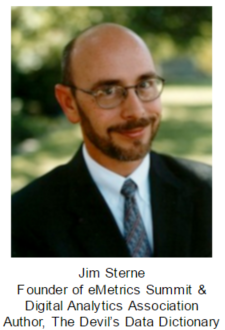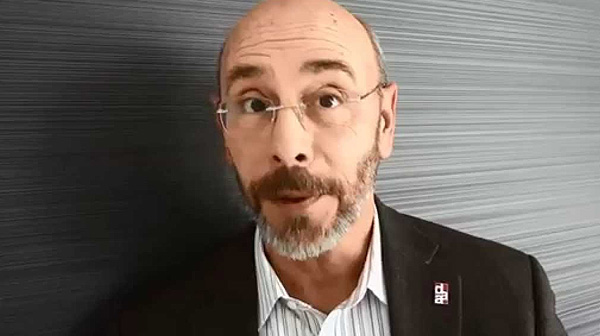Recently, Jim Sterne, published his new book: “The Devil’s Data Dictionary.” I decided to use this opportunity to interview Jim about, arguably the most unusual book about analytics, and certainly the most entertaining one. While on the call with Jim, we covered many other topics – analytics, big data, and what it takes to become a data artist. Jim is the founder of eMetrics, author of numerous books on analytics, and one of the leaders of the analytics industry.
 ML: You are a person who needs no introduction in the world of analytics, but how would you introduce yourself on a plane?
ML: You are a person who needs no introduction in the world of analytics, but how would you introduce yourself on a plane?
JS: I run a conference and a professional association about measuring the success of your website. It’s that simple. And if they say, “Oh, you mean like digital analytics and big data?” Okay, well then it’s a conversation.
ML: Do you see yourself more as an author, a marketer, or a conference founder?
JS: I’m going to go for community leader.
ML: Your first book, “World Wide Web Marketing: Integrating the Web Into Your Marketing Strategy” was published in 1995. So much has changed but what do you think has stayed the same over the past 20 years?
JS: The difficulty in approaching all of this stuff from the customer’s perspective. My whole intent has always been, “How do we make the web better?” The user experience is really difficult. It’s awkward. It’s painful. So how do we make it better? And then I eventually got to the point of, “Oh, analytics, that’ll be the best thing.” So okay, well how do you measure what you’re doing? And are you measuring the right things? Are you measuring it from your customer’s perspective?
ML: So why is customer experience still a struggle for so many companies?
JS: We get so focused on what we’re trying to sell, how we’re selling it. What silos of data do we have? What are our processes? How do we become more efficient? We get so focused on those things that we forget that there’s somebody on the other side of the screen who’s having a huge amount of trouble just getting something simple done.
ML: Your book, “Web Metrics” led to the eMetrics Summit. What topics do you see in demand right now? What do people want to learn?
JS: Well, so you originally asked what has not changed. And the topics everybody want to know are always, “How do I convince my boss? How do I get more funding? How do I hire more people? How do I increase the tool set? How do I convince everybody in the company that this is really awesome?” That will never stop. So the technology will continue to move on, and as it does, we’ll have to convince whoever is in control of the budget, that they should invest.
ML: Do we have a lot of executives who don’t get it? Or do we have a lot of people who are trying to explain it using the wrong terminology?
JS: The number of people who don’t get it is dwindling, fortunately. There have always been people out there who don’t get it but they’re also not being given education in a very clear way. The most common problem is the analyst who wants to explain this incredible discovery they’ve made. But in order to reveal how incredible it is, they have to explain how complicated it was and how difficult it was, and how dirty the data was. And that’s the wrong conversation. It’s a classic change management problem. The conversation should be: “Here is an opportunity. Here’s how I think we can take advantage of the opportunity. And the outcome is more sales, lower costs, happier customers. And here’s an inexpensive way we can test it. What do you think?”
ML: Besides the natural evolution of eMetrics, are you planning any changes to the conference over the next few years? Is there anything new that attendees should expect?
JS: There are four big changes:
1. It’s the good old eMetrics Summit. We’re sticking with the formula.
2. We are reaching out for more advanced technology. Who’s using this latest and greatest stuff, and how are they working it? Yesterday, I had a great call with Intuit and their Turbo Tax team and they’re using machine learning in the product itself, in order to manage the user interaction, as well as email marketing and moving into A/B split testing.
3. Our east coast conference in October – we’ll be moving to New York City. We spent a few years in Boston, now we’re going to be at Javits Center.
4. Digital Analytics Association has come up with the competency framework. It is a list of what do we do for a living and what tasks do we perform. For each task it shows what knowledge and skills you need to perform that task. Now that it has been spelled out, the eMetrics Summit can say, “Okay, well we’re going to address these particular components that we’re going to match up with the presentations to the skills and knowledge that are needed. And it’s a little more formal, rather than just, “Hey, I heard this great presentation, let’s have this guy give the talk.” Now it’s going to be a little more structured from an education perspective.
ML: Let’s shift gears to your book, “The Devil’s Data Dictionary.” Why this book and this format? Why now?
JS: Why now is because it’s about time we made fun of ourselves.
ML: So from that book do you have now a favorite joke about data or analytics? And maybe a favorite definition?
JS: One that gets the best response from people who are not in the analytics industry is algorithm. Even my father liked that one. “Algorithm – regularly recurring remarks from the former US VP who invented the internet: Al Gore rhythm.” So that kind of stuff is just very silly. Probably my favorite which is: “Normal distribution is sitting as far from each other as possible in an uncrowded auditorium. But the corollary is abnormal distribution, and that is republicans voting for universal health care.”
ML: The book is very much about the visuals as it is about the definitions. But in the business world, analysts are really struggling with being visual when presenting their information. Do you have any recommendations for them?
JS: Visualizations are going to draw your attention to things that don’t make sense. Or draw your attention to outliers that need to be explored. That’s incredibly valuable because we consume data visually so much faster than we do if we’re looking at rows and columns or even if we’re reading a paragraph. So if you put data like expenses and revenues in a PowerPoint, like two dimensional, as simple as possible, then it makes sense to people.
ML: Are there any misconceptions about analytics industry?
JS: People think that we are accountants and bean counters. How many people came to my website? How well did my ad do? How many people clicked on this button? Those are the wrong questions to ask, and we can’t really answer those questions, because we’re dealing in improbability and likelihood and fuzzy, vague numbers because of cached files. Data is messy. So when somebody thinks we’re doing accounting that’s a misconception.
Inside the industry perhaps the biggest misconception is the critical need to understand the business – period. It doesn’t matter how good I am with the data or how good I am at the math. If I don’t know what the business goals are, or if I don’t know how that person does his or her job, I can’t help them with the numbers.
ML: In order for me to help the readers, do have any shortcuts? Maybe certain business questions that you can suggest people ask to understand business objectives?
JS: Well the best question to ask is why? If someone asks “How many people came to our website?” Well I could tell you, I can give you the number, and I can tell you what it was yesterday, and I can tell you what it is tomorrow. But what are you actually trying to accomplish with that number? If you ask why then you become a partner in helping them accomplish their goal. I asked my analyst, “I’m spending money on Facebook and I’m spending money on Linkedin. Which one’s more worthwhile?” And her response was, “What do you mean worthwhile? How do you define success?” And I thought, “Oh I like this person, okay.”
ML: Many organizations have published an industry trends report and the commonality among them is that we will have a shortage of analytics talent. You can argue that we’re already there, but we definitely will be there in the next 2 to 3 years. How can organizations prepare for this?
JS: Find people who already work for you who are curious and are interested.
ML: I’ve read the white paper that you wrote “From Data Scientist to Data Artist”. How does one become a data artist?
JS: You have a higher goal in mind. It’s the difference between being a house painter and a portrait painter. You can crunch the numbers. You can create dashboards, that’s great. And that’s your job, and in order to do that, you’ve got to all the data collection and data cleaning and all the painful stuff. But why are you doing that? An artist has to mix colors and clean brushes and do all of the same thing that the house painter does. But the goal of the artist is to illicit an emotion, and not just deliver a report. You could say “27 people came to my website today.” So what? Or you could say, “I’m really scared that only 27 people came to our website today, and I think there might be these problems, and I think there might be this solution.” I want to instill in the listener an emotion and a desire to fix the problem.
ML: I saw that you are going to speak at SuperWeek in Hungary, and I loved the title of your presentation, “Einstein Was Wrong: Everything That Can Be Counted Counts.” Can you give us a short preview about the topic? And how did you decide to challenge Einstein?
JS: Because of big data and because of machine learning, everything that you can count might be valuable. Every attribute you can collect might be useful, and it’s beyond human comprehension at this point, but we have machine learning and predictive analytics to help us sift through all that data, and figure out whether it’s important or not. And which bits are important. So a little tongue in cheek, but he said, “Not everything that can be counted counts.” I think it can. He said, “Not everything that counts can be counted.” And that’s why I will begin my presentation with the Browning poem, “How do I love thee, let me count the ways?”
ML: When you have questions about analytics or when you want to learn more – what are your sources of knowledge that we can share with our readers?
JS: Depends on the kind of question. If it’s a philosophical question or an organizational question, I might go to John Lovett or Gary Angel or some of the old guard people who have implemented analytics many times over. If I want an overview, industrial strength perspective of where we’re headed, Tom Davenport. If I need a technical answer that I can understand about say, Google Analytics, I go to Justin Cutroni.
ML: What do you wish you knew about analytics when you were getting started?
JS: I guess – buy Google stock, I don’t know? One that took me a long time to learn is I wish I had known how egocentric experts are. If somebody gets up on stage and claims to be an expert, they want you to come and ask them a question. You should never be afraid of them. They are delighted when you validate them as an expert by asking them a question. When I think of all the great people I was exposed to that I could have gone right up to and asked for a business card, and they would’ve appreciated that. If I’d only known that and not been shy, I could’ve learned a lot more a lot faster.
ML: When you organize your conferences, or when you write your books, is there one common thing that you want your audience to do better?
JS: Yeah, it’s customer experience. It goes back to – how can you make this website easier to use? How can you make this purchase process less painful?
Resources
1. Connect with Jim Sterne – LinkedIn, Twitter
2. The next eMetrics Summit is scheduled for April 3-6 in San Francisco. Early bird registration ends on February 5.
3. Additional reading: Jim Sterne’s books
4. A look inside Jim Sterne’s recent book The Devil’s Data Dictionary
5. The Digital Analytics Association Competency Framework is the first-of-its-kind industry reference. DAA members can download a copy here.
6. Follow the eMetrics YouTube Channel
7. From Data Scientist to Data Artist by Jim Sterne
8. Superweek 2016 is coming up on February 1-5 in Hungary.
9. Industry experts that were mentioned in the interview – John Lovett, Gary Angel and Justin Cutroni.



